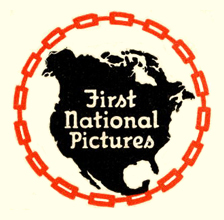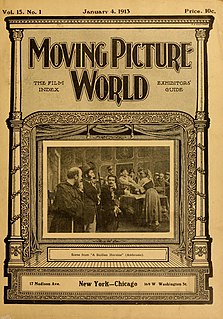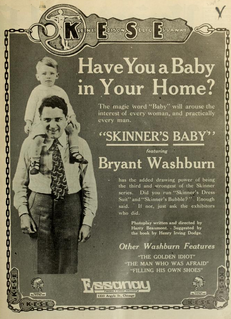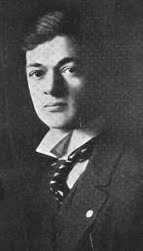
First National Pictures was an American motion picture production and distribution company. It was founded in 1917 as First National Exhibitors' Circuit, Inc., an association of independent theatre owners in the United States, and became the country's largest theater chain. Expanding from exhibiting movies to distributing them, the company reincorporated in 1919 as Associated First National Theatres, Inc., and Associated First National Pictures, Inc. In 1924 it expanded to become a motion picture production company as First National Pictures, Inc., and became an important studio in the film industry. In September 1928, control of First National passed to Warner Bros., into which it was completely absorbed on November 4, 1929. A number of Warner Bros. films were thereafter branded First National Pictures until July 1936, when First National Pictures, Inc., was dissolved.
The Motion Picture Patents Company, founded in December 1908 and terminated seven years later in 1915 after conflicts within the industry, was a trust of all the major US film companies and local foreign-branches, the leading film distributor and the biggest supplier of raw film stock, Eastman Kodak. The MPPC ended the domination of foreign films on US screens, standardized the manner in which films were distributed and exhibited within the US, and improved the quality of US motion pictures by internal competition. But it also discouraged its members' entry into feature film production, and the use of outside financing, both to its members' eventual detriment.
The National Legion of Decency, also known as the Catholic Legion of Decency, was a Catholic group founded in 1934 by Archbishop of Cincinnati, John T. McNicholas, as an organization dedicated to identifying for Catholic audiences, objectionable content in motion pictures. Members were asked to pledge to patronize only those motion pictures which did not "offend decency and Christian morality". The concept soon gained support from other churches.

The Hoyts Group of companies in Australia and New Zealand includes Hoyts Cinemas and Val Morgan. Hoyts operates more than 450 cinema screens and 55,000 seats, making it Australia's second largest movie exhibitor after Event Hospitality and Entertainment. Val Morgan sells advertising on cinema screens and digital billboards.
The Top Ten Money Making Stars Poll were polls on determining the bankability of movie stars. They began quite early in the movie history. At first, they were popular polls and contests conducted in film magazines, where the readers would vote for their favorite stars, like the poll published in New York Morning Telegraph on 17 December 1911. Magazines appeared and disappeared often and among the most consistent in those early days were the polls in the Motion Picture Magazine.

Thomas Hayes Hunter was an American film director and producer of the silent era. He directed a total of 34 films between 1912 and 1934.
Harrison's Reports was a New York City-based motion picture trade journal published weekly from 1919 to 1962. The typical issue was four letter-size pages sent to subscribers under a second-class mail permit. Its founder, editor and publisher was P. S. Harrison (1880–1966), who previously had been a reviewer for Motion Picture News, in which his column was titled "Harrison’s Exhibitor Reviews".
The Motion Picture Herald was an American film industry trade paper published from 1931 to December 1972. It was replaced by the QP Herald, which only lasted until May 1973. It was established as the Exhibitors Herald in 1915.

Dinty is a 1920 American silent comedy drama film written by Marshall Neilan and John McDermott specifically for Wesley Barry, a young actor known for his freckled complexion. Prominent among the supporting players were Colleen Moore, Marjorie Daw, Pat O'Malley, and Noah Beery.

The Moving Picture World was an influential early trade journal for the American film industry, from 1907 to 1927. An industry powerhouse at its height, Moving Picture World frequently reiterated its independence from the film studios.

Motion Picture was an American monthly fan magazine about film, published from 1911 to 1977. It was later published by Macfadden Publications.
The Combine was the name given to the association between exhibitor Union Theatres and the production and distribution company Australasian Films on 6 January 1913. The Combine had a powerful influence on the Australian film industry of the 1910s and 1920s and was frequently the subject of criticism for hampering Australian production, including by filmmakers such as Raymond Longford.

The Strange Adventures of Prince Courageous, also known as The Adventures of Prince Courageous, is a 1923 American silent fantasy film series starring Bessie Love and five-year-old Arthur Trimble, directed by Frederick G. Becker.

Skinner's Baby is a 1917 American silent comedy film starring Bryant Washburn, Hazel Daly, James C. Carroll, and U.K. Haupt. This film projected Washburn out of obscurity; it was quite a success. It was Jackie Coogan's first film role, as the baby, though uncredited. The film is believed to be lost.

Martin Joseph Quigley Sr. was an American publisher, editor and film magazine journalist. He founded Exhibitors Herald, which became an important national trade paper for the film industry. He was also the founder of Quigley Publishing.

Motography was an American film journal that was first published in 1909 and ran until mid-1918. The magazine was published in 1909 and was originally named The Nickelodeon, but then changed its name to Motography in 1911. The trade journal was published monthly by Electricity Magazine Corporation, with offices in both New York and Chicago. Motography was one of the most popular American Film trade papers, and was read primarily by individuals in the film industry, such as movie directors and movie theater owners. In 1918, Martin Quigley bought Motography merging it with Motion Picture Herald.

Motion Picture Daily was an American daily magazine focusing on the film industry. It was published by Quigley Publishing Company, which also published the Motion Picture Herald. The magazine was formed by the merging of three existing Quigley publications: Exhibitors Trade Review, Exhibitors Daily Review, and Motion Pictures Today. The first issue was published in April 1931. The magazine was in circulation until 1972.

Wray Bartlett Physioc was an American film director, producer and artist. His film The Gulf Between (1917) was the first Technicolor film ever produced.
The Avenging Trail is a 1917 American silent drama film directed by Francis Ford and starring Harold Lockwood, Sally Crute, and Joseph Dailey. It was released on December 31, 1917.

Pearl Doles Bell was an American novelist, film scenarist, radio script writer, and editor. During her career, she published eight novels and had numerous stories adapted into silent films. She was especially known for writing film stories for silent film star Shirley Mason.














